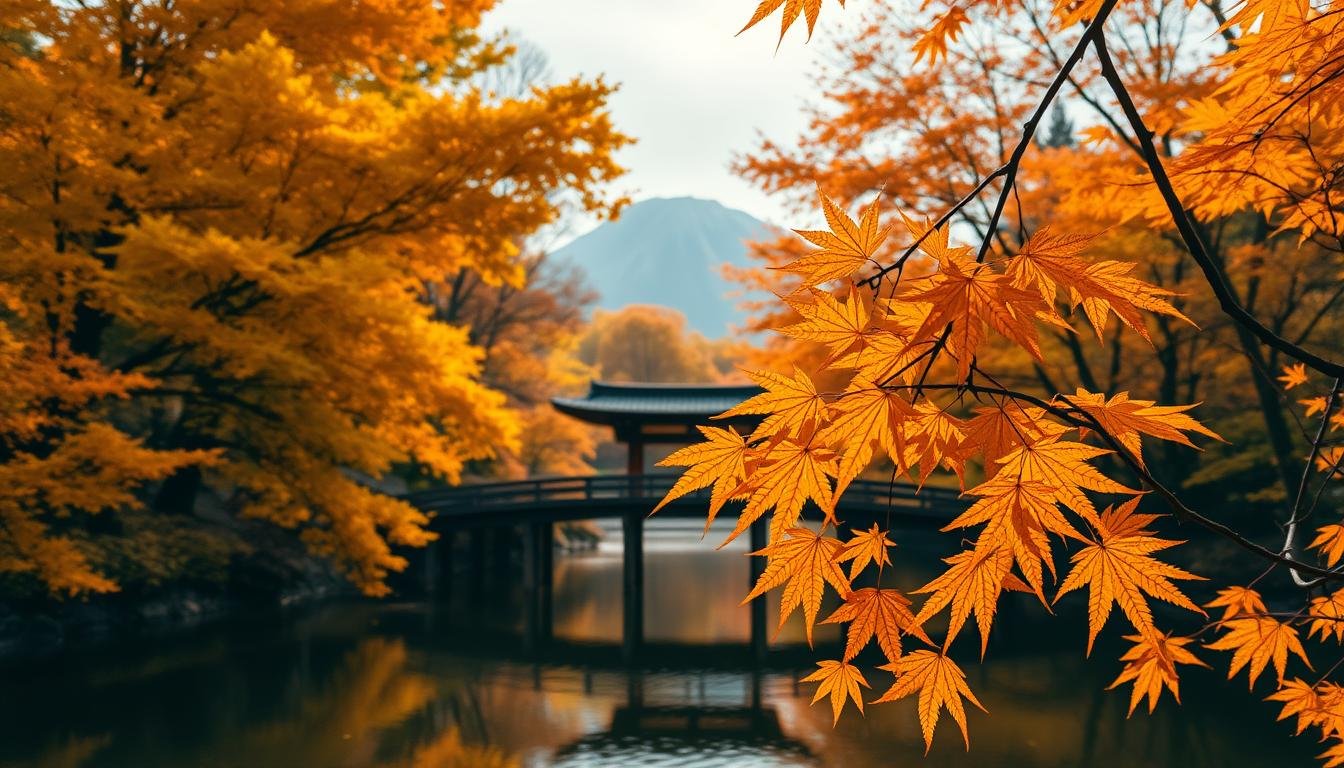Japan is famous for spectacular autumn color—each year the country’s mountains, gardens, temples, and city streets transform into a vivid palette of red, orange, and gold. Planning your visit during peak koyo season means choosing the right region at the right time to make the most of the spectacle.
Best Places to See Autumn Leaves in Japan — a mix of city parks, mountain trails, and temple gardens.
As the season progresses from Hokkaido in the north down to Kyushu in the south, popular destinations across Japan become top spots to visit for foliage viewing. Whether you prefer a city stroll beneath ginkgo-lined avenues, a temple-lit evening, or a crisp hike on mountain trails, Klook experiences and guided tours can simplify logistics so you spend more time enjoying the leaves and less time planning your trip.
Key Takeaways
- Best Places to See Autumn Leaves in Japan are spread across regions—plan north to south for the best timing.
- Peak months vary by area; check the latest autumn leaves Japan forecast before you travel.
- Mix city highlights (ginkgo avenues) with rural hikes and temple illuminations for a balanced trip.
- Book Klook tours and day trips early during peak weeks to secure guides, transport, and entry times.
- Use this guide to pick places and timing that match your schedule and travel style.
The Magic of Autumn in Japan
Autumn in Japan—known locally as koyo season—is a cultural and natural highlight of the year. The tradition of koyo (leaf viewing) draws both locals and visitors to parks, temple gardens, mountains, and city streets to appreciate the brief, stunning display of color.
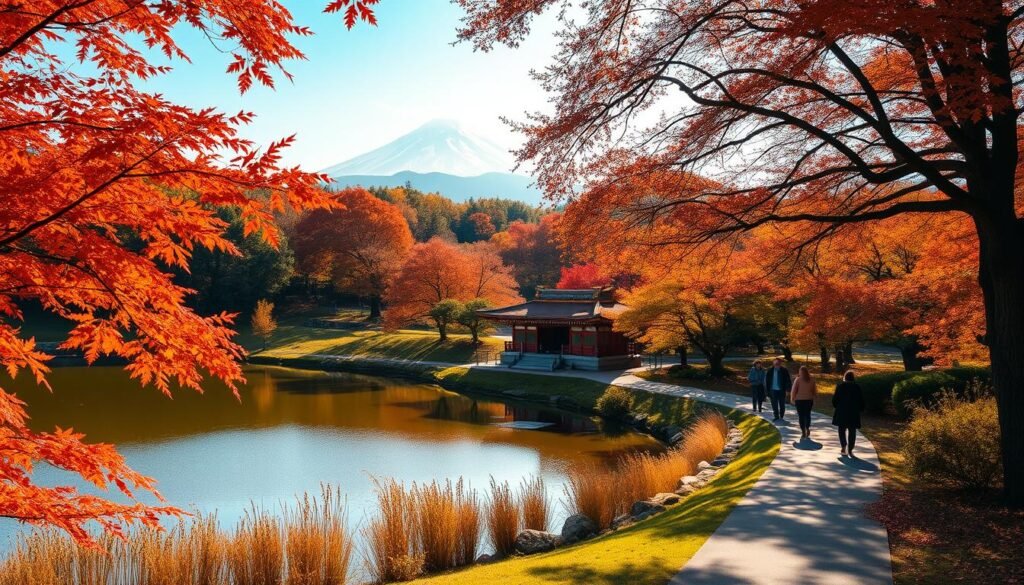
Understanding Koyo: The Japanese Tradition of Leaf Viewing
Koyo isn’t just sightseeing—it’s a cultural practice that celebrates impermanence and invites people to slow down and connect with nature. Common koyo activities include leisurely walks in gardens, evening temple light-ups, and mountain hikes that showcase vivid maples and ginkgo trees.
Keep in mind that timing and experience vary by region and year; local festivals and illuminations often coincide with peak color but can change depending on weather.
When to Visit: Japan’s Autumn Color Calendar
Timing your trip is crucial—autumn colors sweep north to south, so plan by region rather than a single fixed date.
The North-to-South Progression of Colors
- Hokkaido: colors often begin in late September (mountain areas can be earlier).
- Tohoku and northern Honshu: peak commonly in mid to late October.
- Kanto (Tokyo) & Kyoto: usually late October to early November for many spots.
- Kyushu: peaks tend to arrive later, often in late November.
Peak Viewing Times by Region
These windows are estimates—year-to-year shifts occur. Before you travel, check a current autumn leaves forecast (live updates are available from national and regional tourism sites) to pick the best time for the specific places you want to visit.
Check the latest autumn leaves forecast to lock in the best time for your trip.
Best Places to See Autumn Leaves in Japan: Northern Region
The north of Japan is one of the earliest regions to hit peak color each year and offers dramatic alpine scenery, historic sites, and wide-ranging hiking trails. From Hokkaido’s high-elevation parks to Aomori’s castle gardens, this area is a top destination for people who want vibrant reds and crisp mountain air.
Daisetsuzan National Park, Hokkaido
Daisetsuzan National Park (often cited as Japan’s largest national park) is a highland paradise for autumn foliage lovers. At higher elevations the alpine vegetation can turn first—maples, birch, and dwarf shrubs blaze in oranges and reds, creating sweeping color across ridgelines.
Best Viewing Spots and Trails
Popular routes include the Kurodake trail (moderate to difficult) and the Sounkyo Gorge area (easier walks and scenic viewpoints). Plan for cooler temperatures even in late September—layers and sturdy footwear are essential on hiking trails. Typical peak: late September to early October at higher elevations, though exact timing varies by year and elevation.
Recommended Klook Tours to Hokkaido
For visitors based in Sapporo, consider booking a guided day or multi-day Klook tour that includes transport, a local guide, and trail options. Tours often list pickup cities, duration, and languages—check each product page for current availability and itinerary details before booking.
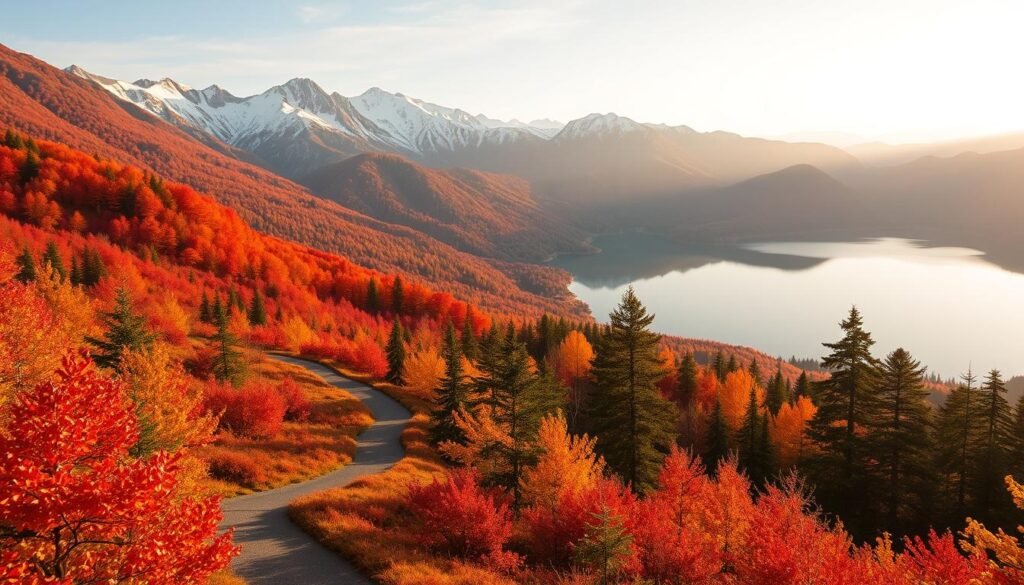
Hirosaki Castle Park, Aomori
Hirosaki Castle Park is famous for thousands of maple and ginkgo trees framing a historic castle—one of the most iconic castle-plus-foliage combinations in Japan. The park’s tree-lined paths and castle moat create classic autumn photos.
Castle and Maple Combination Views
Walk the moat perimeter and the castle grounds for multiple vantage points; early mornings during mid-October often give the best light and fewer crowds. Many photographers time visits for the soft morning light that enhances the red and gold tones.
Getting There and Entry Information
Hirosaki Park is accessible by local bus or taxi from Hirosaki city center. Entry fees and opening times can change for special events—confirm with the official Hirosaki tourism site before you visit. Typical peak color in Hirosaki is mid to late October, but check the current autumn leaves forecast for the exact year.
Both Daisetsuzan National Park and Hirosaki Castle Park are excellent examples of northern-region foliage: the highland, early-season displays of Hokkaido and the temple-and-castle views of Aomori together make this part of Japan one of the best places see autumn color. When planning, consult the latest forecast and add 1–2 extra days as a buffer—peaks can shift by a week year to year.
Tokyo and Surrounding Areas
When autumn arrives, Tokyo and nearby regions turn into a colorful mix of city parks, temple gardens, and mountain trails — an easy combination of urban sightseeing and nature. Use Tokyo as a base to visit ginkgo-lined avenues, take a day trip to a nearby national park, or hike for panoramic fall views.
Meiji Jingu Gaien’s Ginkgo Avenue
Meiji Jingu Gaien is famous for its Ginkgo Avenue, where rows of ginkgo trees turn vivid yellow in late November (estimate). The straight, sunlit boulevard makes for striking photos — try backlit shots in the late afternoon to make the golden leaves glow.
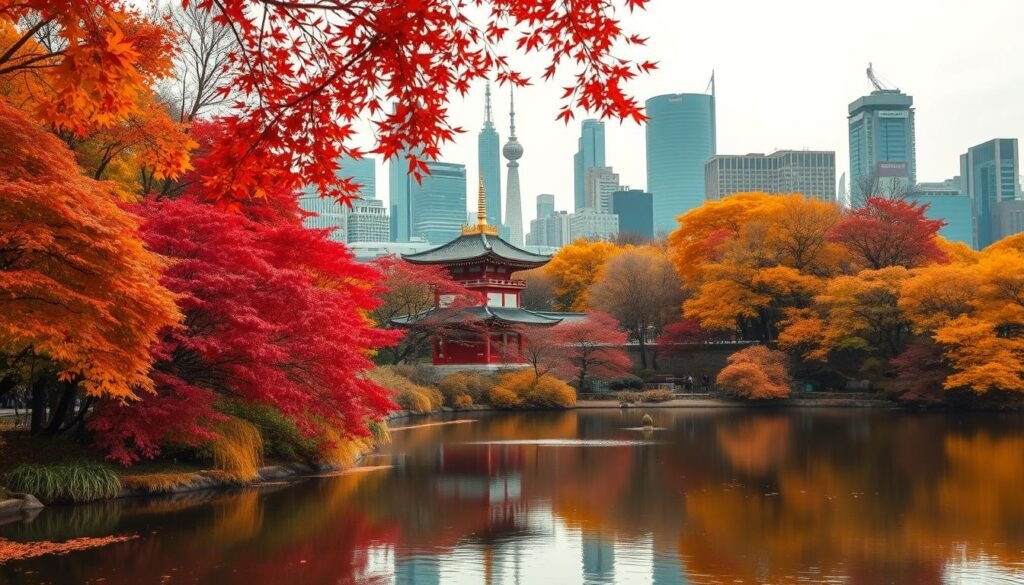
Mount Takao
Mount Takao is a popular day trip from central Tokyo and offers accessible hiking trails with excellent autumn color. Trails range from gentle walking paths to more strenuous routes; many paths are lined with maples and provide impressive canopy color.
Hiking Routes for Best Autumn Views
Choose an easy trail if you want a relaxed walk, or a moderate route for better viewpoints. Typical best time for Mount Takao is late October to early November, but check the forecast for the year you plan to visit.
Cable Car Options and Day Trip Plans
If you prefer less hiking, the cable car takes you most of the way up — great for families and visitors who need an easier option. Ideal day plan: depart Tokyo in the morning, hike or ride cable car, enjoy an early lunch by the summit, and return by late afternoon. Guided day trips (often listed on Klook) run 6–9 hours and sometimes include return transport.
Nikko National Park
Nikko National Park — a UNESCO World Heritage area about two hours from Tokyo by train (fastest routes vary by operator) — combines ornate temples with mountain scenery. Lake Chuzenji and Kegon Falls are standout autumn spots where leaves frame dramatic landscapes.
Lake Chuzenji and Kegon Falls
Lake Chuzenji’s shoreline and the Kegon Falls lookout produce memorable vistas in mid to late October. Expect cooler temperatures and pack layers. For photography, try morning light for softer tones and fewer crowds.
Klook Day Tours from Tokyo to Nikko
For convenience, Klook offers day tours from Tokyo to Nikko that typically include transportation, a guide, and visits to key sites — some include lunch. These tours are a good option for travelers short on time; check each product for languages offered (English, Chinese, Japanese) and exact duration before booking.
Practical tip: always check the current autumn leaves forecast before traveling — peak windows shift year to year. If you’re planning a short trip, prioritize a single area (city ginkgo avenue or a mountain park) to maximize time enjoying the colors rather than rushing between spots.
Kyoto’s Iconic Autumn Landscapes
Kyoto is one of the best places see autumn color in Japan—its temples, historic streets, and gardens turn into a tapestry of red, orange, and gold that draws visitors from around the world. Plan visits around typical peak windows and illumination schedules to get the most out of the season.
Arashiyama Bamboo Grove and Togetsukyo Bridge
Arashiyama combines the quiet vertical lines of the bamboo grove with riverside views from the historic Togetsukyo Bridge. In autumn the surrounding maples and ginkgo trees add vibrant color to the scene, making this one of the city’s must-see spots.
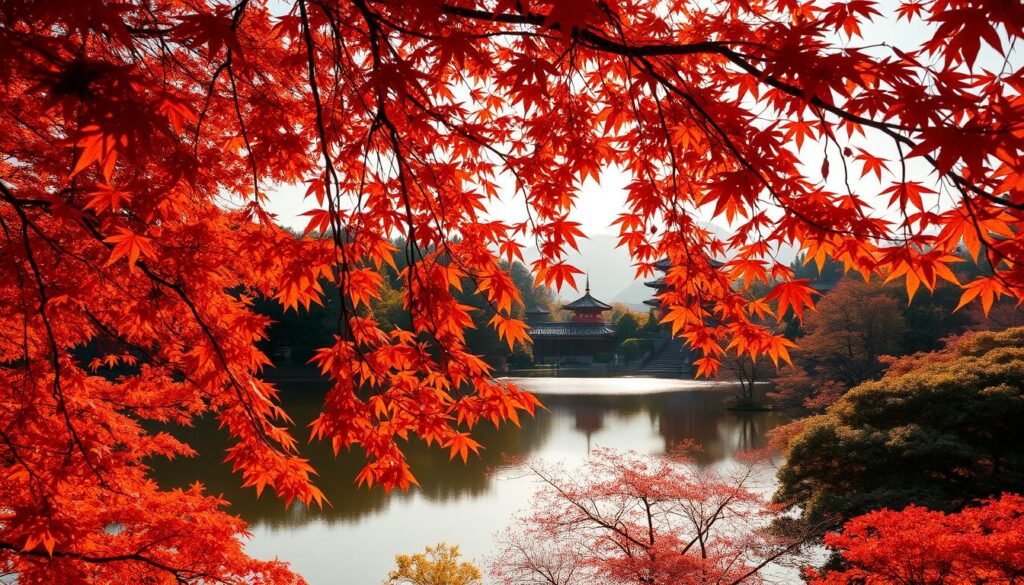
Tofukuji Temple
Tofukuji is famous for its temple gardens and the Tsutenkyo Bridge viewpoint, where rows of maples fill the valley below. The sweeping red and orange canopy is especially dramatic during mid to late November in typical years.
The Famous Bridge View
For the classic shot, position yourself on Tsutenkyo Bridge or the temple’s upper walkways during morning light. If you prefer fewer people, aim for early morning entry or late afternoon when crowds thin.
Best Times to Avoid Crowds
Kyoto’s most popular temple spots get crowded—visit Tofukuji and Arashiyama early in the day (before 9am) or later in the afternoon. Night illuminations are beautiful but draw heavy crowds; if you go, expect lines and possible timed-entry tickets.
Kiyomizu-dera Temple
Kiyomizu-dera’s wooden stage overlooks a broad valley that explodes with color in autumn. The panorama of Kyoto’s cityscape framed by maples is a highlight for many visitors and photographers.
Panoramic Views of Kyoto in Autumn
Visit for clear, sweeping vistas during mid to late November (estimate). For sunrise colors and fewer people, consider arriving before opening. Note that tripod use and flash may be restricted during evening illuminations—check the site rules.
Recommended Klook Kyoto Cultural Tours
To deepen your experience, book a Klook Kyoto cultural tour that includes guided visits to Kiyomizu-dera, Tofukuji, and Arashiyama. Look for tours that list durations (half-day vs full-day), language options (English, Chinese, Japanese), and whether they include museum or tea-house stops. During peak season, book tours several weeks in advance to secure your preferred date and time.
Quick planning tip: many Kyoto spots peak in mid–late November, but exact timing shifts year to year—always check the latest autumn leaves forecast before you finalize travel dates. Combining daytime temple visits with one or two evening illuminations gives a full sense of Kyoto’s autumn beauty.
The Japanese Alps Region
The Japanese Alps are a top destination for autumn color—high mountain valleys, historic villages, and rural onsen towns combine dramatic foliage with traditional culture. This region rewards hikers and casual sightseers alike with wide vistas, rustic architecture, and bright maples that peak slightly later than some lowland cities.
Kamikochi in Nagano Prefecture
Kamikochi is a highland valley famous for mirror-like river views and broad autumn palettes. The area offers multiple hiking routes suitable for different abilities and is especially lovely when the larch and maple leaves turn gold and crimson.
Hiking Routes Among Autumn Colors
Trails in Kamikochi range from easy riverside walks to longer mountain routes—ideal for day hikers and those wanting multi-day treks. Wear layers: temperatures can drop quickly at altitude. Typical peak color is mid to late October, though this shifts by year and elevation.
Transportation and Accommodation Tips
Most visitors reach Kamikochi by bus from Shinshimashima Station (which is served from Matsumoto). Parking is limited near the park entrance; consider public transport or staying overnight in Matsumoto or a nearby lodge. Book accommodations well in advance during peak weeks—lodging is limited in this highland destination.
Shirakawa-go and Takayama
Shirakawa-go and nearby Takayama showcase traditional gassho-zukuri farmhouses framed by fall foliage—a UNESCO World Heritage destination that’s especially photogenic in autumn.
Traditional Villages in Fall Colors
Wander the village lanes and viewpoints for classic compositions of steep-roof houses against a backdrop of colored trees. Peak timing is usually mid to late November in lower-elevation valleys, but check the forecast for the exact year.
Klook Tours to Shirakawa-go and Hida Takayama
Consider booking a Klook tour for seamless transport and guided walks—many tours include round-trip buses from nearby cities and local guides. For short trips, choose a 1-day route that hits Takayama markets and Shirakawa-go viewpoints; for deeper exploration, a 2-day plan allows time for hiking, an onsen stay, and relaxed village visits.
Nearby alpine routes such as the Tateyama Kurobe Alpine Route are also spectacular in autumn—check weather and route closures before you travel, as the Tateyama Kurobe alpine route can have seasonal restrictions. If you plan to combine hiking and onsen relaxation, pack appropriate footwear, layered clothing, and reserve lodgings early in the season.
Hidden Gems for Autumn Leaf Viewing
If you want brilliant color without the biggest crowds, Japan has many lesser-known spots that reward visitors with intimate valleys, quiet walking trails, and local festivals. These hidden gems are perfect for day trips and short stays—and often pair foliage viewing with onsen relaxation or local cuisine.
Korankei Gorge, Aichi Prefecture
Korankei Gorge is a peaceful mountain valley famous for vibrant maple trees that blaze in mid to late November (estimate). The gorge’s walkways and viewpoints create classic compositions of red maples against rocky riverbanks.
The Maple Valley Festival
The Maple Valley Festival highlights the best of the season with evening illuminations, local food stalls, and cultural performances. Dates vary by year—check the local festival site or an autumn leaves forecast before you go.
Day Trip Options from Nagoya
Korankei is a convenient day trip from Nagoya—take a local train or bus, then a short walk to the scenic areas. Sample itinerary: depart Nagoya early, arrive mid-morning, stroll the gorge and have lunch at a riverside restaurant, return by late afternoon. Book limited-seat buses in advance during peak weeks.
Naruko Gorge, Miyagi Prefecture
Naruko Gorge is a dramatic ravine known for steep cliffs, a fast-flowing river, and excellent autumn colors framed by hot-spring towns. The area combines scenic walking trails with nearby onsen options for a comforting post-hike soak.
The Spectacular Ofukazawa Bridge View
The Ofukazawa Bridge lookout offers one of Naruko’s most photographed views—maples tumbling down the valley with a sweeping river below. Peak color is usually in mid to late October, but check the forecast for the specific year.
Getting There from Tokyo or Sendai
Naruko Gorge is reachable by train from Sendai (and by connecting services from Tokyo). The scenic rail journey is a highlight itself—consider staying overnight in a local ryokan to enjoy an onsen after your hike.
Quick itinerary ideas: Korankei—one-day loop from Nagoya; Naruko—train from Sendai with an overnight onsen stay. Book Naruko Gorge Autumn Leaves & Ginzan Onsen One Day Bus Tour for a convenient, guided option that combines scenic viewpoints with onsen time (check language and departure city). Always check the latest autumn leaves forecast and reserve transport and onsen rooms early during peak season.
Autumn Festivals and Special Events
Autumn in Japan pairs spectacular foliage with lively festivals and evening illuminations—perfect if you want cultural experiences alongside colorful landscapes. Plan around event dates and expect larger crowds at popular light-ups and festival weekends.
Fujikawaguchiko Autumn Leaves Festival
The Fujikawaguchiko Autumn Leaves Festival (typically held in late October to early November; dates vary by year) showcases brilliant maples and a striking view of Mt. Fuji framed by fall color. Evening illuminations and lakeside displays make this a top spot for photographers and day-trippers.
Mt. Fuji Views with Autumn Colors
Visit Lake Kawaguchi viewpoints for classic Fuji-plus-foliage shots—arrive before sunset for golden-hour light and fewer people. Check local transport schedules; many visitors use organized tours to avoid driving and parking hassles.
Klook Mt. Fuji and Lake Kawaguchi Tours
Featured option: [Mount Fuji Autumn Leaves Tour]— a seasonal day trip that typically includes guided visits around Fuji Kawaguchiko Maple Corridor, where you can enjoy the stunning dance of Mount Fuji and autumn leaves! Book early—this trip runs during peak color and often sells out.
Eikando Temple Light-up, Kyoto
Eikando Temple is famous for its autumn light-up events when maple trees are illuminated after dark, creating a magical, lantern-lit atmosphere. These evening illuminations usually occur in mid to late November but vary by year.
Evening Illumination Experience
Expect crowds and timed entry at popular illuminations—arrive early, and be prepared for restricted tripod use in some venues. For low-light photography, use a fast lens and higher ISO; follow site rules about tripods and flash.
Combining with Other Kyoto Night Viewing Spots
To make the most of Kyoto’s night viewing, combine Eikando with nearby illuminated temples or gardens in one evening—plan logistics carefully and allow time for travel between sites. Always check the latest autumn leaves forecast and official illumination schedules for the exact year before booking.
Practical Tips for Your Autumn Foliage Trip
Japan’s autumn is spectacular, but timing and preparation make the difference between a rushed photo stop and a relaxed, memorable experience. These practical tips cover packing, transport, booking, and photography so your trip runs smoothly.
What to Pack for Autumn in Japan
Pack layers for fluctuating temperatures—mornings can be chilly even when afternoons warm up. Essentials: a lightweight insulated jacket, a waterproof shell, comfortable walking shoes, warm socks, a small daypack, power adapter, portable charger, and a compact umbrella. If you plan on hiking, add sturdy boots and a warm hat.
Transportation Options
Japan’s public transport is punctual and extensive, making it easy to move between cities and regional parks. For longer multi-region trips a Japan Rail Pass can be cost-effective, while regional passes save money if you stay in one area. For city travel, use IC cards like Tokyo Subway Ticket or Pasmo for convenient tap-and-go fares.
Japan Rail Pass Benefits
The Japan Rail Pass covers many JR shinkansen and limited express trains—ideal on a longer autumn trip that visits multiple regions. Note: some private lines and certain limited services are excluded, and seat reservations are recommended for busy travel days.
Klook Discount Tickets and Passes
Klook often lists discounted tickets, regional passes, and attraction bundles—compare offerings and book in advance during peak weeks to secure dates and better prices. Compare passes and book in advance to lock in preferred travel times and tour slots.
Money & Booking Tips
Book accommodations and popular tours several weeks to months ahead during peak foliage—Kyoto and other top places fill quickly. Check cancellation policies and consider refundable options if dates depend on the autumn leaves forecast. Carry some cash for rural areas where cards may be less widely accepted.
Photography Tips for Capturing Fall Colors
Timing is everything: early morning and late afternoon (golden hour) produce the richest colors. For trails and gardens choose softer light to reduce harsh shadows and saturated highlights.
Best Times of Day for Photography
Try sunrise or just before sunset for warm directional light. Midday can wash out color, but overcast conditions often help saturate reds and greens.
Recommended Equipment and Settings
A mirrorless or DSLR with a mid-range zoom (24–70mm) and a telephoto (70–200mm) covers most scenes. A polarizing filter reduces glare and deepens skies; use a fast lens and higher ISO for evening illuminations where tripods may be restricted. Always respect site rules—some temples and night events prohibit tripods or long exposures.
Safety and Courtesy
Respect local customs: avoid blocking trails for photos, follow queuing norms, and be mindful during temple visits and night illuminations. Check the latest autumn leaves forecast for the year and plan flexible routes—peaks shift by region and by year, so allow an extra day or two where possible.
Planning Your Perfect Japanese Autumn Adventure
With so many best places see autumn color in Japan, a little planning goes a long way. Decide how many days you have, pick one or two regions to avoid rushed travel between cities, and use forecasts to time your visit—peaks shift by year and by elevation.
Sample Itineraries for Different Trip Lengths
5 days: Base yourself in Tokyo and take day trips to nearby spots such as Nikko National Park and Mount Takao (ideal for a city + mountain mix). 7 days: Add Kyoto’s iconic landscapes—Arashiyama, Tofukuji, and Kiyomizu-dera—for classic temple-and-garden views. 10 days: Expand into the Japanese Alps (Kamikochi, Shirakawa-go) or combine Hokkaido and Honshu for highland color and city contrasts.
Booking Accommodations and Tours in Advance
Peak weeks (mid–late October through late November, depending on region) fill quickly—book hotels, timed temple entries, and popular tours several weeks to months in advance. Check cancellation policies and consider refundable options if your dates hinge on the autumn leaves forecast.
Featured Klook Autumn Tours (seasonal — check availability)
- Day Tour to Hoheikyo, Jozankei, Lake Toya, Showa Shinzan, and Mount Yotei Spring Water Park (From Sapporo) — Full-day trip from Sapporo; excellent for day-trippers wanting varied landscapes and onsen-area views. Languages vary by product page. Book early for peak season.
- Watarase Keikoku Railway Company Limited & Takatsudo Gorge One-day Maple Leaf & Autumn Tour — Scenic rail journey combined with gorge walking; best season late October–early November. Reserve seats in advance.
- [Kyushu Autumn Special] Yabakei & Kokonoe Yume Bridge from Fukuoka — Day trip from Fukuoka to dramatic gorges; peak typically in late November. Ideal for short southern-Japan excursions.
- [Autumn Only] Kyushu Saga Fall Foliage Viewing Day Tour|Dazaifu+Kunen-an+Environmental Art Forest+Mifuneyama Rakuen+Yutoku Inari Shrine|Chinese and English Tour Guide — Autumn-only itinerary with bilingual guides; full-day tour showcasing Saga’s gardens and shrines. Check languages and seasonal schedule.
- [Mount Fuji Autumn Leaves] Lake Kawaguchi Maple Leaf Festival & All-You-Can-Eat Grapes & Matsutake Mushroom Set Menu Day Trip — Seasonal festival trip around Lake Kawaguchi featuring local produce and fungus-themed set meals; typically timed to late October–early November festival dates. Book the culinary festival tour while it runs.
- Naruko Gorge Autumn Leaves & Ginzan Onsen One Day Bus Tour — Guided bus from Tokyo/Sendai with scenic stops and optional onsen time—an easy way to combine hiking trails and hot-spring relaxation. Great for combining foliage and onsen in one day.
Booking Checklist
- When to book: Secure accommodation and popular tours at least 4–12 weeks ahead during peak season; longer for Kyoto and major illumination nights.
- Cancellation windows: Review refund policies—opt for flexible bookings if you must adjust dates based on the autumn leaves forecast.
- Language & group size: Check tour language availability (English, Chinese, Japanese) and group size limits before booking.
Last-minute planning tip: use a live autumn leaves forecast to pick the best region for your travel dates (late September for Hokkaido, mid–late October for Tohoku and Alpine routes, late October–early November for Kanto/Kyoto, and late November for some Kyushu spots). Add an extra day or two as a buffer—the best time can shift by a week or more year to year.
Plan now: compare tour dates, check the autumn leaves forecast, and book the Klook tours that match your preferred regions and travel days. Consider implementing structured data (Tour, Event) for featured tours and festival dates if you publish these offerings online to improve discoverability in search results.

